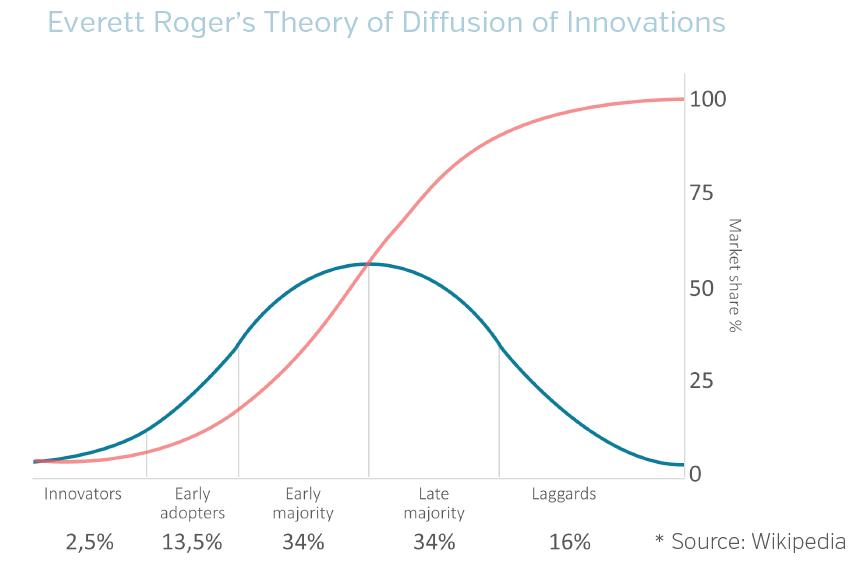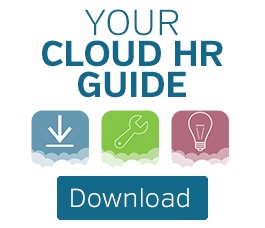Cloud HR solutions are here to stay. Considering another scenario right now is very complicated, media bombardment is relentless and everything is already offered in the cloud. Innovators who started to work with the cloud some years ago have been left behind (and probably have already changed services at least once). We now find ourselves transiting between the Early Adopters and the Early Majority, in line with the Theory of Diffusion of Innovations by Everett Rogers.
In this scenario, while providers try to get as close as possible to pure cloud (everything standard for all, no customizations nor adaptations) to improve maintenance costs for customers and for their own development and evolution, we may get the impression that there is little room for innovation in our own HR processes.
So are we facing a future where we will all be guided by best practices in business that come pre-configured on a platform we share with many other companies? What happens when we need an innovative HR policy to attract and retain talent?
If we don’t get a convincing answer to these questions and a one-size-fits-all HR solution in our hands, then perhaps it’s time to put to aside our concerns for improving processes and to be content with what we have, or seek out ways and shortcuts that let us incorporate our processes within the HR provider’s range of solutions offered.
Everyone has a little non-conformist inside; so if we’re reading this, it’s because we are in this second group and we want to know how we can develop our HR policies within a cloud solution. Here I give ten tips to go about this:
- Find a flexible and configurable platform. To be innovative in our HR processes, the first step is to choose a platform offering us a high level of adaptability within their own processes, configuration settings, different mandatory and optional steps for defining functionality, field configurations, easy to integrate with other platforms, etc.
- Have clearly identified the HR processes you want to improve and the impact within the organization. The definition of a new innovative HR process cannot only be created as a great idea put to our platform provider for deployment. It must be well established in order to upload it to the cloud, to analyze the impact on organizational culture, the benefits it can bring, the internal cost of transmitting and incorporating it, etc.
- Familiarity with the functional capabilities of your platform and make the most of them. This implies fully involving the solution deployment team to get the best out of the work sessions with the platform provider‘s consultants, the training sessions supporting deployment, manuals, additional support tools available from the provider. To do this, we have to think creatively, change the way we work based on the suggestions from the platform functionality, and use elements that were designed to do something for our greater benefit.
- Study the provider’s evolving cycles and methodology. Finding out our platform provider’s focus for development, at what times and how often does it accept requirements from their customer base for platform improvements and the best language for communicating with customers, will give us more advantage. This enables the platform to evolve by incorporating our innovative HR processes.
- Provide constructive alternatives and solutions within the functional framework of the platform. We know that there is no perfect cloud HR platform; in fact, all are constantly evolving, such that our provider will be much more open to our suggestions and comments if the approach is positive rather than destructive or offensive. After all, at the end of the day, we chose them and not the other way around.
- Keep up to date about best practices through different knowledge centers: forums, social networks, virtual media, etc…Awareness of the latest news about the cloud and HR practices being implemented in other companies can help us keep an open mind and an innovative spirit within our team. You never know what piece of random information may provide us with the key to completing a process that we have half defined.
- Be an active member of the user community of your platform, participate in events promoted by the provider, offer talks on the deployment we have done for other platform users. Stimulating dialogue with them may facilitate the identification of common problems and solutions. This way we can together put forward to our provider the best solution for everyone, while complying with the internal policy for platform evolution.
- Volunteer to participate in the development of new functionality. If we work directly with our provider to develop new functionality or adapt an existing one, we can contribute our best working practices for that particular functionality—even if it isn’t complete, we can still get some of it reflected in the platform.
- Become a recognized creator or promoter of new best HR practices. This is the most difficult point to cultivate, since we cannot all be in the top 500 of the most influential companies, nor have big budgets and policies for promoting human resources. Fortunately we live in times when it is much easier to reach people interested in specific content and self-publishing is the order of the day in social networks. Once people get talking about our HR policy, it’s far easier to convert it into a best practice in the market, and this is the way the HR platforms evolve.
- Create custom functionality linked to your It’s an impossible task to find a platform that meets all our needs or in some way immediately fix what’s missing. This is not the ideal scenario; however we can choose creative solutions over specific needs. This also implies we must have the ability to develop functionality complementing the platform offering to cover our needs—and never replacing, because if it did, it wouldn’t make sense to contract the platform. Our IT department can use the surplus budget resulting from freeing up work teams and we can always give our provider a demo on how we supplement what is missing.
If you want to learn more on the topic get this e-book for free!:









